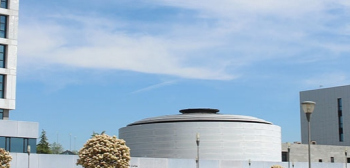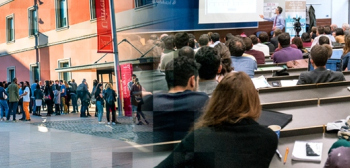萨拉曼卡大学
About
The University of Salamanca will go through a time of unprecedented expansion with the creation of the first American universities, which from 1551 begin to be founded following the wake of the Salamanca by using their founding letters as a model. More than 70% of the universities created in the sixteenth and seventeenth centuries now consider the University of Salamanca their 'alma mater'.
The University of Salamanca has an important material heritage in the form of historic buildings and emblematic spaces that are still active and receive the visit of hundreds of people every day. Especially noteworthy is the Main School Building with its Plateresque façade, inside which stands the Historical General Library with 2,774 manuscripts, 483 incunabula and around 62,000 volumes printed between the 16th and 18th centuries.
The science and technology developed at the University of Salamanca have led some of the most important advances of recent centuries. From the Salamanca studio came personalities such as Torres Villarroel and Abraham Zacut. The advanced thinking of Francisco de Vitoria has made Salamanca the cradle of International Law, but other illustrious figures have passed through its classrooms, such as Fray Luis de León or Francisco de Salinas or Antonio de Nebrija, creator of the first grammar of Spanish. In more recent times, the University has welcomed great thinkers and statesmen like Miguel de Unamuno, Enrique Iglesias, Jacques Delors or Adolfo Suárez.
At present, the University of Salamanca continues to maintain its great capacity for attraction and has a stable student population of around 30,000 students. Account to serve you with nine campuses distributed between Salamanca, Ávila, Zamora, Béjar and Villamayor among which are distributed the 26 faculties and colleges and the 12 research centers. Another of the distinctive features of the University is the teaching of Spanish that attracts thousands of foreign students in different educational programs.
From the International Courses Society the Diplomas of Spanish as a Foreign Language (DELE) have been developed for years and, recently, an agreement signed with the Cervantes Institute, the National Autonomous University of Mexico and the University of Buenos Aires, has made the University of Salamanca leads, along with them, the development of the first digital certificate of Spanish (SIELE) that can be done from anywhere in the world and will carry the certification of the study of Salamanca as a guarantee of its validity.
About
The University of Salamanca will go through a time of unprecedented expansion with the creation of the first American universities, which from 1551 begin to be founded following the wake of the Salamanca by using their founding letters as a model. More than 70% of the universities created in the sixteenth and seventeenth centuries now consider the University of Salamanca their 'alma mater'.
The University of Salamanca has an important material heritage in the form of historic buildings and emblematic spaces that are still active and receive the visit of hundreds of people every day. Especially noteworthy is the Main School Building with its Plateresque façade, inside which stands the Historical General Library with 2,774 manuscripts, 483 incunabula and around 62,000 volumes printed between the 16th and 18th centuries.
The science and technology developed at the University of Salamanca have led some of the most important advances of recent centuries. From the Salamanca studio came personalities such as Torres Villarroel and Abraham Zacut. The advanced thinking of Francisco de Vitoria has made Salamanca the cradle of International Law, but other illustrious figures have passed through its classrooms, such as Fray Luis de León or Francisco de Salinas or Antonio de Nebrija, creator of the first grammar of Spanish. In more recent times, the University has welcomed great thinkers and statesmen like Miguel de Unamuno, Enrique Iglesias, Jacques Delors or Adolfo Suárez.
At present, the University of Salamanca continues to maintain its great capacity for attraction and has a stable student population of around 30,000 students. Account to serve you with nine campuses distributed between Salamanca, Ávila, Zamora, Béjar and Villamayor among which are distributed the 26 faculties and colleges and the 12 research centers. Another of the distinctive features of the University is the teaching of Spanish that attracts thousands of foreign students in different educational programs.
From the International Courses Society the Diplomas of Spanish as a Foreign Language (DELE) have been developed for years and, recently, an agreement signed with the Cervantes Institute, the National Autonomous University of Mexico and the University of Buenos Aires, has made the University of Salamanca leads, along with them, the development of the first digital certificate of Spanish (SIELE) that can be done from anywhere in the world and will carry the certification of the study of Salamanca as a guarantee of its validity.
University highlights
- 2012#451- 500
- 2014#441-450
- 2015#481-490
- 2016#551-600
- 2017#651-700
- 2018#601-650
- 2019#591-600
- 2020#601-650
- 2021#601-650
- 2022#651-700
- 2023#601-650
- 2024#=534
- 2025#=539
- 2026#=526
Campus locations
Salamanca,
Patio de Escuelas, 1 , Salamanca , Spain , Spain , 37008
Béjar,
Béjar , Salamanca , Spain ,
Zamora,
Zamora , Zamora , Spain ,
Ávila,
Ávila , Ávila , Spain ,
Similar Universities
University College of Hospitality Management Sant Pol de Mar, Barcelona
Ctra. N-II km 664, Sant Pol de Mar
ESCP Europe - Madrid
c/ Arroyofresno, 1, Madrid
卡斯蒂利亚 - 拉曼恰大学
Calle Altagracia 50, Ciudad Real
胡安卡洛斯国王大学
Calle del Tulipán, Móstoles - Madrid
Barcelona Graduate School of Economics
Carrer de Ramon Trias Fargas 25, Barcelona






















